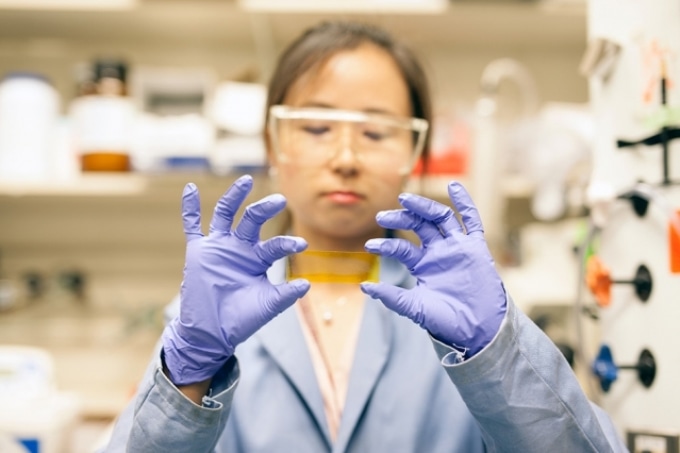Nov 17 2017
In several regions of the developing world, people have plentiful heat from the sun during the day, but majority of the cooking happens later in the evening when the sun sets, using fuel - such as wood, dung or brush - that is gathered with substantial time and effort.
 MIT postdoc, Grace Han, handles a new chemical composite that could provide an alternative to fuel by functioning as a kind of thermal battery. (Photo: Melanie Gonick/MIT)
MIT postdoc, Grace Han, handles a new chemical composite that could provide an alternative to fuel by functioning as a kind of thermal battery. (Photo: Melanie Gonick/MIT)
Currently, researchers at MIT have developed a new chemical composite that could provide an alternative. It could be used to store the sun’s heat from the sun or any other source during the day in a kind of thermal battery, and it could discharge the heat when required, for example for heating after dark or cooking.
A common method to thermal storage is to use what is referred to as a phase change material (PCM), where input heat melts the material and its phase change (from solid to liquid) stores energy. When the PCM is cooled back to below its melting point, it turns back into a solid, upon which the stored energy is discharged as heat. There are a number of examples of these materials, including fatty acids or waxes used for low-temperature applications, and molten salts used at high temperatures. But all existing PCMs require a considerable amount of insulation, and they pass through that phase change temperature in an unregulated manner, losing their stored heat comparatively quickly.
Instead, the new system employs molecular switches that alter shape in response to light; when combined into the PCM, the phase-change temperature of the hybrid material can be modified with light, allowing the thermal energy of the phase change to be maintained even a lot below the melting point of the original material.
The latest findings, by MIT postdocs Grace Han and Huashan Li and Professor Jeffrey Grossman, are published this week in the journal Nature Communications.
The trouble with thermal energy is, it's hard to hold onto it.
Professor Jeffrey Grossman, MIT
So his team created what are fundamentally add-ons for traditional phase change materials, or, "little molecules that undergo a structural change when light shines on them." The trick was to discover a way to combine these molecules with conventional PCM materials to discharge the stored energy as heat, on demand. "There are so many applications where it would be useful to store thermal energy in a way lets you trigger it when needed," he says.
The researchers achieved this by integrating the fatty acids with an organic compound that reacts to a pulse of light. With this procedure, the light-sensitive component modifies the thermal properties of the other component, which stores and emits its energy. The hybrid material melts when heated, and after being exposed to UV light, it remains melted even when cooled back down. Subsequently, when activated by another pulse of light, the material resolidifies and returns back the thermal phase-change energy.
By integrating a light-activated molecule into the traditional picture of latent heat, we add a new kind of control knob for properties such as melting, solidification, and supercooling.
Professor Jeffrey Grossman
Professor Grossman, is the Morton and Claire Goulder and Family Professor in Environmental Systems as well as professor of materials science and engineering.
The system could employ any source of heat, not just solar, Han says. "The availability of waste heat is widespread, from industrial processes, to solar heat, and even the heat coming out of vehicles, and it's usually just wasted." Harnessing some of that waste could deliver a way of recycling that heat for beneficial applications.
"What we are doing technically," Han explains, "is installing a new energy barrier, so the stored heat cannot be released immediately." In its chemically stored form, the energy can stay for long periods until the optical trigger is stimulated. In their preliminary small-scale lab versions, they demonstrated that the stored heat can stay stable for a minimum of 10 hours, while a device of similar size storing heat straightaway would disperse it within a few minutes. And, "there's no fundamental reason why it can't be tuned to go higher," Han says.
In the preliminary proof-of-concept system, "the temperature change or supercooling that we achieve for this thermal storage material can be up to 10 °C (18 °F), and we hope we can go higher," Grossman says.
Already, in this version, "the energy density is quite significant, even though we're using a conventional phase-change material," Han says. The material can store approximately 200 joules per gram, which she says is, "very good for any organic phase-change material." And already, "people have shown interest in using this for cooking in rural India," she says. These kinds of systems could also be used for space heating or drying agricultural crops.
Our interest in this work was to show a proof of concept, but we believe there is a lot of potential for using light-activated materials to hijack the thermal storage properties of phase change materials.
Professor Jeffrey Grossman